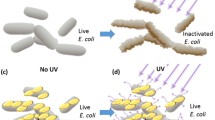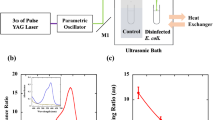Abstract
Although antimicrobial photothermal inactivation of naked gold nanostructures using powerful pulsed lasers has been previously studied, there are little reports about their photodynamic antimicrobial properties under the irradiation of low-power density continuous wave lasers. Therefore, this paper attempts to fill this gap. In this paper, we studied the effects of a 40-mW/cm2 continuous Nd:Yag laser at 532 nm and naked gold nanoparticles on inactivation of Escherichia coli ATCC25922. According to our results, 60 min illumination using the Nd:Yag laser caused a 0.15log reduction of the bacterial viability. Also, the employed gold nanoparticles with an average size of 15 nm were toxic to E. coli ATCC 25922 in the concentrations above 0.5 μg/ml. In addition, synergistic effects of 0.5 μg/ml gold nanoparticles and the light illumination led to a 2.43log reduction of the viability after a 60-min exposure and did not show any considerable temperature change on the media. The obtained results were justified based on the possible interaction mechanisms of low-power density laser lights and naked gold nanoparticles. The paper is proposed as a prelude for future research about localized inactivation of resistant pathogens with minimum side effects on neighbor tissues.








Similar content being viewed by others
References
Fischbach MA, Walsh CT (2009) Antibiotics for emerging pathogens. Science 325:1089–1093
Levy SB, Marshall B (2004) Antibacterial resistance worldwide: causes, challenges and responses. Nat Med 10:122–129
Kolar M, Urbanek K, Latal T (2001) Antibiotic selective pressure and development of bacterial resistance. Int J Antimicrob Agents 17:357–363
Colomb-Cotinat M, Lacoste J, Brun-Buisson C, Jarlier V, Coignard B, Vaux S (2016) Estimating the morbidity and mortality associated with infections due to multidrug-resistant bacteria (MDRB) , France, 2012. Antimicrob Resist Infect Control 5:56
Zharov VP, Mercer KE, Galitovskaya EN, Smeltzer MS (2006) Photothermal nanotherapeutics and nanodiagnostics for selective killing of bacteria targeted with gold nanoparticles. Biophys J 90:619–627
Ablaka ME, Daniyan SY, Adeyemone SO, Damisa D (2014) The antibacterial efficacy of gold nanoparticles derived from Gomphrenacelosioides and Prunusamygdalinus (almond) leaves on selected bacterial pathogens. Int J Biol Macromol 8:348–351
Yin R, Agrawal T, Khan U, Gupta GK, Rai V, Huang YY, Hamblin MR (2015) Antimicrobial photodynamic inactivation in nanomedicine: small light strides against bad bugs. Nanomedicine (London) 10:2379–2404
Sherwani MS, Tufail S, Khan AA, Owais M (2015) Gold nanoparticle-photosensitizer conjugate based photodynamic inactivation of biofilm producing cells: potential for treatment of C. albicans infection in BALB/c mice. PLoS One 10:1–20
Dreaden EC, Austin LA, Mackey MA, El-Sayed MA (2012) Size matters: gold nanoparticles in targeted cancer drug delivery. Ther Deliv 3:457–478
Simon-Deckers A, Brun E, Gouget B, Carriere M (2008) Impact of gold nanoparticles combined to X-ray irradiation on bacteria. Gold Bull 41:187–194
Minai L, Yeheskely-Hayon D, Yelin D (2013) High levels of reactive oxygen species in gold nanoparticle-targeted cancer cells following femtosecond pulse irradiation. Sci Rep 3:2146
Dykman LA, Khlebtsov NG (2011) Gold nanoparticles in biology and medicine: recent advances and prospects. Acta Nat (англоязычная версия) 3(2)
Giljohann DA, Seferos DS, Daniel WL, Massich MD, Patel PC, Mirkin CA (2010) Gold nanoparticles for biology and medicine. Angew Chem Int Ed 49:3280–3294
Maliszewska I, Lisiak B, Popko K, Matczyszyn K (2017) Enhancement of the efficacy of photodynamic inactivation of Candida albicans with the use of biogenic gold nanoparticles. Photochem Photobiol 93:1081–1090
Darabpour E, Kashef N, Amini SM, Kharrazi S, Djavid GE (2017) Fast and effective photodynamic inactivation of 4-day-old biofilm of methicillin-resistant Staphylococcus aureus using methylene blue-conjugated gold nanoparticles. Journal of Drug Delivery Science and Technology 37:134–140
Wijesiri N, Ozkaya-Ahmadov T, Wang P, Zhang J, Tang H, Yu X, Ayres N, Zhang P (2017) Photodynamic inactivation of multidrug-resistant Staphylococcus aureus using hybrid photosensitizers based on amphiphilic block copolymer-functionalized gold nanoparticles. ACS Omega 2:5364–5369
Doherty RE, Sazanovich IV, McKenzie LK, Stasheuski AS, Coyle R, Baggaley E, Bottomley S, Weinstein JA, Bryant HE (2016) Photodynamic killing of cancer cells by a platinum (II) complex with cyclometallating ligand. Sci Rep 6:22668
Kuramochi Y, Ishitani O (2016) Iridium (III) 1-phenylisoquinoline complexes as a photosensitizer for photocatalytic CO2 reduction: a mixed system with a Re (I) catalyst and a supramolecular photocatalyst. Inorg Chem 55:5702–5709
Luo J, Chen LF, Hu P, Chen ZN (2014) Tetranuclear gadolinium (III) porphyrin complex as a theranostic agent for multimodal imaging and photodynamic therapy. Inorg Chem 53:4184–4191
Luong HB, Kim JS, Kim JC (2011) Size, optical and stability properties of gold nanoparticles synthesized by electrical explosion of wire in different aqueous media. Rev Adv Mater Sci 28:117–121
Kariminezhad H, Habibi M, Mirzababayi N (2015) Nanosized ZSM-5 will improve photodynamic therapy using methylene blue. J Photochem Photobiol B Biol 148:107–112
Pamies R, Cifre JGH, Espín VF, Collado-González M, Baños FGD, de la Torre JG (2014) Aggregation behavior of gold nanoparticles in saline aqueous media. J Nanopart Res 164:2376
Barreto Â, Luis LG, Girão AV, Trindade T, Soares AM, Oliveira M (2015) Behavior of colloidal gold nanoparticles in different ionic strength media. J Nanopart Res 17:493
Botasini S, Méndez E (2013) Silver nanoparticle aggregation not triggered by an ionic strength mechanism. J Nanopart Res 15:1526
Yue K, Tang J, Tan H, Lv X, Zhang X (2018) Nanoparticle aggregation in ionic solutions and its effect on nanoparticle translocation across the cell membrane. J Heat Transf 140:012003
Huanga X, El-Sayed MA (2010) Gold nanoparticles: optical properties and implementations in cancer diagnosis and photothermal therapy. J Adv Res 1:13–28
Fu PP, Xia Q, Hwang HM, Ray PC, Yu H (2014) Mechanisms of nanotoxicity: generation of reactive oxygen species. J Food Drug Anal 22:64–75
Manke A, Wang L, Rojanasakul Y (2013) Mechanisms of nanoparticle-induced oxidative stress and toxicity. Biomed Res Int 2013:1–15
Huang WC, Tsai PJ, Chen YC (2007) Functional gold nanoparticles as agents for selective-killing of pathogenic bacteria. Nanomedicine (Lond) 2:777–787
Qin Z, Bischof JC (2012) Thermophysical and biological responses of gold nanoparticle laser heating. Chem Soc Rev 41:1191–1217
Misawa M, Takahashi J (2011) Generation of reactive oxygen species induced by gold nanoparticles under x-ray and UV irradiations. Nanomedicine 7:604–614
Kawasaki H, Kumar S, Li G, Zeng C, Kauffman DR, Yoshimoto J, Iwasaki Y, Jin R (2014) Generation of singlet oxygen by photoexcited Au25 (SR) 18 clusters. Chem Mater 26:2777–2788
Sakamoto M, Tachikawa T, Fujitsuka M, Majima T (2009) Photochemical reactivity of gold clusters: dependence on size and spin multiplicity. Langmuir 25:13888–13893
Cabiscol Català E, Tamarit Sumalla J, Ros Salvador J (2000) Oxidative stress in bacteria and protein damage by reactive oxygen species. Int Microbiol 3(1):3–8
Kashmiri ZN, Mankar SA (2014) Free radicals and oxidative stress in bacteria. Int J Curr Microbiol App Sci 3:34–40
Bhattacharya S (2015) Reactive oxygen species and cellular defense system. In: Free radicals in human health and disease. Springer India, pp 17–29
Sen T, Patra A (2012) Recent advances in energy transfer processes in gold-nanoparticle-based assemblies. J Phys Chem C11(6):17307–17317
Satio H, Nosaka Y (2014) Mechanism of singlet oxygen generation in visible-light-induced photocatalysis of gold-nanoparticle-deposited titanium dioxide. J Phys Chem C 118:15656–15663
Kang Z, Yan X, Zhao L, Liao Q, Zhao K, Du K, Zhang K, Zhang X, Zhang Y (2015) Gold nanoparticles/ZnO nanorods hybrids for enhanced reactive oxygen species generation and photodynamic therapy. Nano Res 8:2004–2014
Chadwick SJ, Salah D, Livesey PM, Brust M, Volk M (2016) Singlet oxygen generation by laser irradiation of gold nanoparticles. J Phys Chem C 120:10647–11057
Pasparakis G (2013) Light-induced generation of singlet oxygen by naked gold nanoparticles and its implications to cancer cell phototherapy. Small 9:4130–4134
Jiang C, Zhao T, Yuan P, Gao N, Pan Y, Guan Z, Zhou N, Xu QH (2013) Two-photon induced photoluminescence and singlet oxygen generation from aggregated gold nanoparticles. ACS Appl Mater Interfaces 5:4972–4977
Yao C, Zhang L, Wang J, He Y, Xin J, Wang S, Xu H, Zhang Z (2016) Gold nanoparticle mediated phototherapy for cancer. J Nanomater 5497136:1–29
Vankayala R, Lin CC, Kalluru P, Chiang CS, Hwang KC (2014) Gold nanoshells-mediated bimodal photodynamic and photothermal cancer treatment using ultra-low doses of near infra-red light. Biomaterials 35:5527–5538
Vankayala R, Huang YK, Kalluru P, Chiang CS, Hwang KC (2014) First demonstration of gold nanorods mediated photodynamic therapeutic destruction of tumors via near infra-red light activation. Small 10:1612–1622
Mfouo Tynga I, Abrahamse H (2018) Nano-mediated photodynamic therapy for cancer: enhancement of cancer specificity and therapeutic effects. Nanomaterials 8:923
Abrahamse H, Kruger CA, Kadanyo S, Mishra A (2017) Nanoparticles for advanced photodynamic therapy of cancer. Photomed Laser Surg 35:581–588
Hong EJ, Choi DG, Shim MS (2016) Targeted and effective photodynamic therapy for cancer using functionalized nanomaterials. Acta Pharm Sin B 6:297–307
Acknowledgments
This work was supported by the Babol Noshirvani University of Technology (grant number is BNUT/370542/97).
Author information
Authors and Affiliations
Corresponding author
Ethics declarations
Conflict of interest
The authors declare that they have no conflict of interest.
Human and Animal Rights and Informed Consent
This paper does not contain any studies with human participants or animals performed by any of the authors. Informed consent was obtained from all individual participants included in the study.
Additional information
Publisher’s note
Springer Nature remains neutral with regard to jurisdictional claims in published maps and institutional affiliations.
Rights and permissions
About this article
Cite this article
Lashkari, S.M., Kariminezhad, H., Safarnezhad, N. et al. Surface plasmon resonance of naked gold nanoparticles for photodynamic inactivation of Escherichia coli. Gold Bull 52, 51–60 (2019). https://doi.org/10.1007/s13404-019-00252-2
Received:
Accepted:
Published:
Issue Date:
DOI: https://doi.org/10.1007/s13404-019-00252-2




